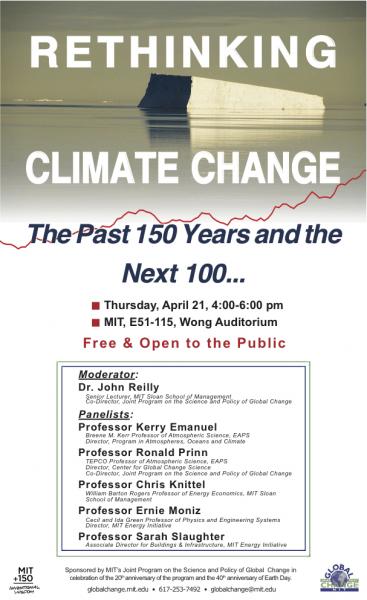Rethinking Climate Change: The Past 150 Years and the Next 100 - Reprised
Rethinking Climate Change: The Past 150 Years and the Next 100 - Reprised
This past April, PAOC's Kerry Emanuel and Ron Prinn spoke at the MITEI sponsored "Rethinking Climate Change" Symposium.
Panelists sketched the past, present and future of climate change with Kerry Emanuel reviewing the science of climate change, noting that the greenhouse effect discovery dates back to the 18th century, and that by the end of the 19th, scientists had already begun worrying that consumption of fossil fuel and the accompanying release of CO2 would lead to an increase in surface temperatures of 5-6°C. Modern science with its ice core measurements has tracked dramatic temperature changes on earth over tens of millions of years. But the last 100 years have been unprecedented, with the famous hockey stick illustration capturing the connection between human industry and increased CO2release. When scientists run some models forward, they show temperature increases ranging from 1.5 to 4°C. While these projections contain uncertainty, says Emanuel, “this does not mean we should do nothing.”
Diverse climate change reconstructions agree: the warmest years of the past century were 1998, 2005 and 2010. “This is happening in real-time,” says Ronald Prinn, and whether or not “Florida has a cold winter,” warming is occurring “at a rate that should worry us all.” The amount of heat the earth absorbs is simply much greater than it can bounce back into space, courtesy of greenhouse gas already accumulated in the atmosphere, and increasingly, by the secondary impacts of climate change such as the melting of ice sheets. At MIT, Prinn’s group runs models that factor in clouds, ocean mixing, and varying levels of greenhouse gas emissions. In a “business as usual” model, with no real efforts to rein in fossil fuel use, Prinn puts the risk of a temperature increase higher than 4°C at 85%. If we manage to stabilize CO2 emissions at 550 parts per million (we’re at 472 today), there is still a 25% chance of getting greater than 2°C change. Prinn worries about the instability of the arctic tundra and permafrost, which stores 200 times the amount of current human emissions in carbon, as well as the acidification of oceans, placing plankton, basis of all ocean life, at risk.
You can read about what other speakers had to say at this MITEI sponsored event at the MIT World website.
